These are our observations of Nebula
-
In the Region of the Summer Stars: The Coathanger Asterism
At last, I've had a few clear nights and managed to get out and enjoy the sky again. I decided to forego the forensic probings of my Ritchey-Chretien scope and take in more of the context around some of our summer objects. So, for the first time, I installed the ASI 071MC camera on my APM 107 refractor and included the 0.75x Riccardi reducer. This combination gives a focal length of 530mm and an image scale of 1.8 arcsec per pixel, which is a bit on the big side and gives around two pixels per star. Thus, the expectation was to see some blocky star images, which I have.
I have observed the Coathanger asterism previously but on this occasion, I deliberately shifted the "Coathanger" to the bottom of the frame so that I could explore the region to its north. The second night was plagued by high, thin clouds, which I did not see while imaging, but they became apparent during processing and produced a blue haze over the image. Rather than lose all the data, I used several tools and processing techniques to reduce the haze, and this image is the result of this work. There are over 19,000 stars in this image, says Pixinsight.

This image of the Coathanger asterism (Cr399) in Vulpecula is by David Davies and taken from Cambridge in the UK. To see more of David's work please visit his Flickr Photostream. Just for a bit of fun, I've been exploring the image and have identified the following objects of interest.
NGC6802: a 10th magnitude open cluster forming an extension of the coathanger bar to the east.

This image of open cluster NGC 6802 in Vulpecula is by David Davies and taken from Cambridge in the UK. IC1299: a very 14th magnitude open cluster to the northwest.

This image of open cluster IC 1299 in Vulpecula is by David Davies and taken from Cambridge in the UK. Sharpless 2-83, a 15th magnitude 2x2 arc-minutes HII region.
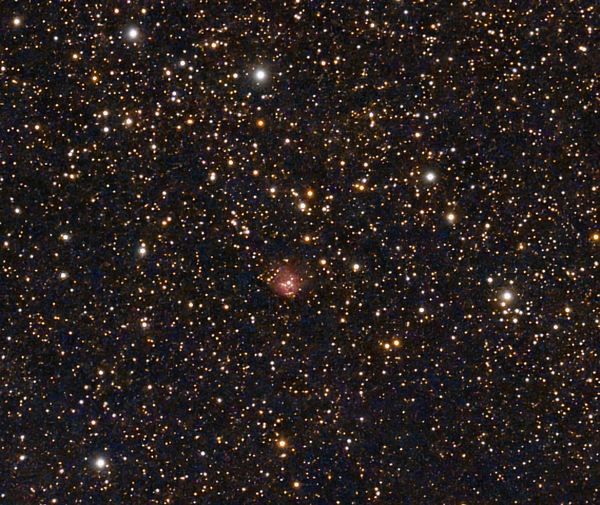
This image of the H-II region Sh2-83 in Vulpecula is by David Davies and taken from Cambridge in the UK. And three planetary nebulae from the Strasbourg-ESO catalogue of planetary nebulae that were discovered by Henize during the 1960s. These are small, faint objects on this image and took a bit of finding, but I think I have them. You might, of course, disagree, but that is fine.
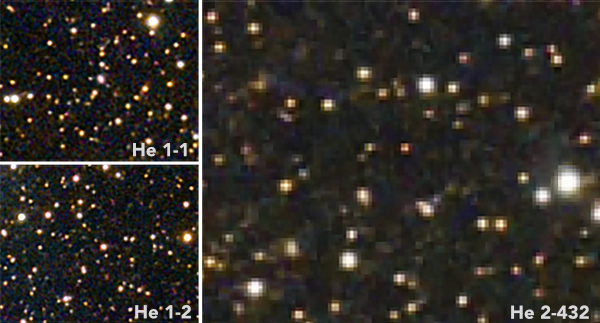
These images of the Henize planetary nebulae around the Coathanger asterism (Cr399) in Vulpecula are by David Davies and taken from Cambridge in the UK. - He 1-1: an 18.5 magnitude planetary nebula, 5 x 5 arcseconds
- He 1-2: a 17.2 magnitude planetary nebula, 5 x 5 arcseconds
- He 2-432: an 18.5 magnitude planetary nebula, 5 x 5 arc seconds
The images of these planetary nebulae have been copied from the original image and magnified. The nebulae are the pinkish star-like objects in the centre of the frame.
I'm astonished at the wealth of detail captured by my somewhat neglected refractor. The objects' brightness range is from 5th magnitude in the coathanger to 18th magnitude from the tiny planetary nebulae - that's around 140,000 times. It's time for a rethink on telescopes going forward, perhaps. I should go back to the objects using my RC telescope and see what it delivers.
Image Details
Data: 80 x 30s RGB sub-images collected on 27th and 28th July 2024.
- Telescope: APM 107 refractor with 0.75x Riccardi reducer flattener
- Camera: ZWO ASI 071 MC Pro
- Mount: Skywatcher EQ8
David Davies - (31 July 2024).
-
Three in one: NGC 6712, IC 1295 and PK 25-4.1
The attached image resulted from something of an experiment to explore what quality of image I might get from using the ASI 294MC Pro one-shot-colour camera to try and capture two low-down, planetary nebulae.
My attention was initially drawn to the globular cluster NGC 6712, but an exploration of that region of the sky with a Cartes du Ciel revealed the planetary nebula IC 1295 close by with the Perek-Kohoutek object, PK 25-4.1 close by. I, therefore, elected to try my RC10 telescope with a 0.7x reducer (finally at its correct spacing) and with the telescope recollimated following some incorrect assumptions concerning the pointing accuracy of my TS_Optics focuser.

A 2x2 binned image of the globular cluster (NGC 6712) in a rich field of stars to the right of the image and IC 1295 to the lower left of the centre by David Davies. Taken from Cambridge in the UK. To see more of David's work please visit his Flickr Photostream. Click on the image for the larger version. NGC 6712 was discovered by William Herschel on June 16th, 1784. It is a relatively small (64 light-years across) and sparse (~1 million stars) globular cluster, which lies 22,500 light-years away.
A study by the European Southern Observatory concludes that NGC 6712 is only a pale remnant of a once much more massive cluster. It notes that none of NGC 6712’s stars is less massive than our Sun, making it totally unlike any globular cluster. Most likely, NGC 6712 is unique only because no other globular cluster comes as close to the Milky Way’s centre as NGC 6712; it penetrates very deeply into the galactic bulge, venturing to within 1,000 light-years of the galactic centre. The tidal force of the galaxy not only strips low-mass stars from the cluster but also stretches out the cluster like a comet’s tail. The ESO study labels NGC 6712 as a peculiar globular cluster. The Interstellarum Deep Sky Atlas labels 6712 as The Weird Globular.
Above is my 2x2 binned image of the full field which shows the globular cluster in a rich field of stars to the right of the image and IC 1295 to the lower left of the centre. I think I can see streams of stars running east of north and west of south from the globular cluster, as described in the literature.
Below is a full-resolution image of the region around IC 1295. IC 1295 is slightly left of the centre, and I believe that PK 25-4.1 is the small bright blue object in an arc of four stars to the upper right of the centre.
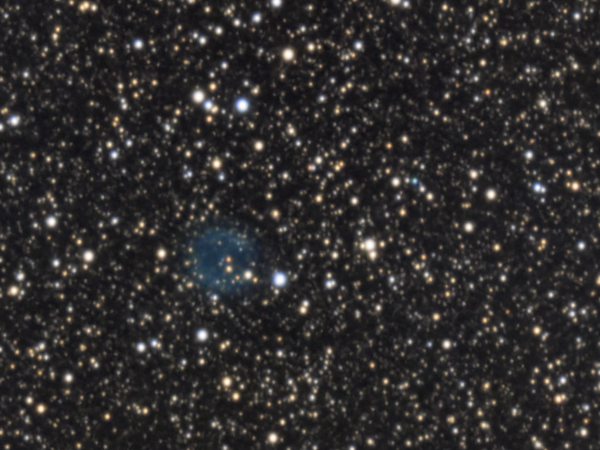
A full-resolution image of the region around IC 1295 by David Davies taken from Cambridge in the UK. Image Details
Data: 60 x 2-minutes exposures from 2nd to 6th October 2022.
- Telescope: 10-inch Ritchey Chretien with a x0.7 reducer at 1400mm focal length
- Camera: ASI 294MC Pro (-15C, gain 120, off 13)
- Mount: Skywatcher EQ8
- Software: NINA, Pixinsight, Photoshop
David Davies - (10 October 2022).
-
A Bit of Fun with M42
I suspect the Orion Nebula, M42, is the most popular target in the beginner astro-imager's sky. So it is not a target I would normally share; I'm sure you've seen many versions. However, here are a couple of images with a bit of a story of me continuing to learn and change.
I'm a member of a small team of astronomers doing online outreach for the Cambridge Institute of Astronomy (IOA). Since lockdown, each clear Wednesday evening during the winter months, we will attempt to observe and present online, objects of particular interest in the night sky, often related to the subject of a talk. This activity certainly tests the mettle of my ability to find and present images of objects quickly and demands the best performance from my equipment.
Last year, therefore, I purchased a ZWO ASI 294 MC Pro camera and Sharpcap to provide colour images quickly with Sharpcap providing imaging stacking in real-time. I've found it to be an excellent electronically assisted astronomy (EAA) tool and it has transformed my enjoyment of observing to one with a more real-time appreciation of objects, as opposed to extended sessions of imaging a single object with my QSI CCD camera.
M42, of course, has been one of our Wednesday evening targets and I've been astonished at the deep contrast between the brightness of the Trapezium core and the much fainter outer reaches of the nebula.
Once our online session had ended, I set about exploring what the ZWO camera could do with the subject. I gathered a range of exposures ranging between 100 x four seconds and 10 x five minutes and then blended the images together in Photoshop. I have two images to share.
The first is of the Trapezium region using exposures ranging from four seconds to two minutes and blending the images to provide a high dynamic range view. Many of the fainter stars in the Trapezium region are well shown but my telescope is not big enough to separate stars e, f and g in the Trapezium.

An image of the Trapezium region using exposures ranging from four seconds to two minutes blended to provide a high dynamic range by David Davies and taken from Cambridge in the UK. To see more of David's work please visit his Flickr Photostream. Click on the image for the larger version. The second image also blends the five minutes exposures of the outer regions of the nebula and shows well the convoluted gas clouds of emission and reflection that are sculpted by the newly born stars at the core.
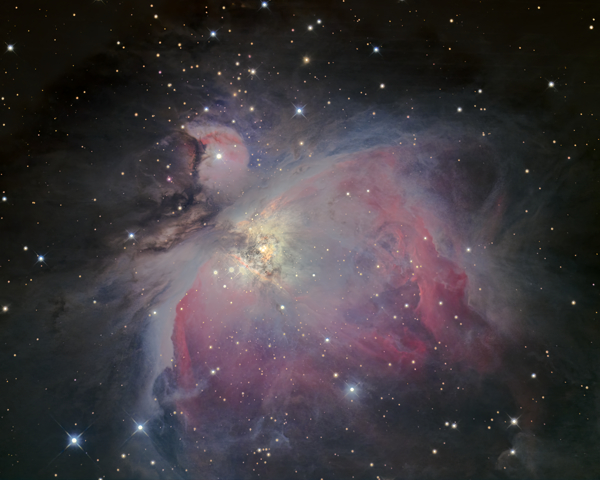
An image of Messier 42 by David Davies and taken from Cambridge in the UK. To see more of David's work please visit his Flickr Photostream. Click on the image for the larger version. Image Details
RGB exposures: 4 secs, 30 secs, 120 secs and 300 secs.
- Telescope: 200mm Ritchey-Chretien plus a 0.7x reducer to give 1160mm focal length at F/5.8
- Camera: ASI ZWO 294 MC Pro
- Mount: Skywatcher EQ8
- Software: Sharpcap, Deep Sky Stacker, Pixinsight, Photoshop, Capture One, Topaz Studio 2, Topaz Denoise AI
David Davies - (20 January 2022).
-
NGC 2237 in Monoceros
I took this last night, but the camera was not cooled, I forgot to set it, think it was the excitement of a clear night!! My observatory is in my back garden in Boughton which is on the edge of Northampton.
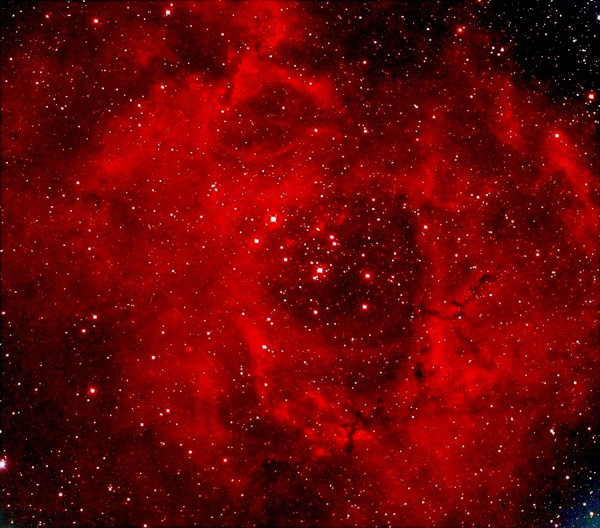
The Rosette nebula (NGC 2237) by Richard Weatherley taken from Northampton. Image Details
It is a 500 second single shot, which has been slightly cropped, taken with a FLI microline colour using sparse configuration in full frame. The result is processed in Maxim.
- Telescope: AG14 Orion F 3.8
- Camera: FLI Microline Camera
Richard Weatherley - (3 January 2022).
-
The Skull Nebula (NGC 246) in Cetus
I've always considered the Skull Nebula to be too low in the sky, with a maximum altitude of just 26 degrees from my location, to image successfully. However, clear skies on the nights of 30th and 31st October gave me an opportunity to attempt it.
NGC 246 is a planetary nebula in the constellation of Cetus and was discovered by William Herschel in 1785. Stephen O'Meara writes about it in his book Deep Sky Companions: The Caldwell Objects and discusses the visibility of the central 12th magnitude star. It turns out that this star is readily visible in my image but it is not the dwarf star responsible for the nebula. The central star is, in fact, at least a triple system. There is a 14 magnitude companion, an orange dwarf star, type G8-K0 V, just 3.8" from the primary. Further, in this link to Stars and Skulls: new ESO image reveals eerie nebula, ESO describes work by the ESO VLT in 2014 that reveals a third red dwarf star.
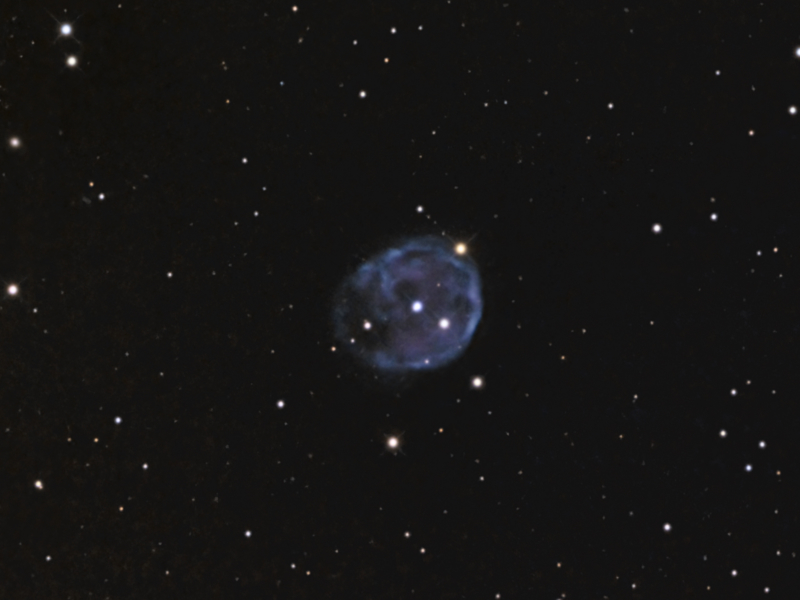
This image of the Skull Nebula (NGC 246) in Cetus was processed and cropped to show off the nebula by David Davies and taken from Cambridge in the UK. To see more of David's work please visit his Flickr Photostream. The first inspection of my captured image revealed that the central star was not round. My first reaction was to think that I had some sort of guiding error but I quickly realised that other stars in the image did not exhibit the same feature and this set me to investigate further. Inspection of the central star revealed a blue-white primary star and an orange companion. There is just a hint of the companion visible in the image processed to bring out the nebula and its structure. I reprocessed the data to see what could be revealed by stretching the image only slightly to limit the blooming of star images. I then used this second image as an additional luminance layer on the original image to reveal the companion 14 magnitude orange dwarf star.

This image of the Skull Nebula's (NGC 246) colourful central stars was reprocessed to show the stars and has been enlarged x2 from the original. Image provided by David Davies and taken from Cambridge in the UK. To see more of David's work please visit his Flickr Photostream. Click on the image for the larger version and a closer look at those stars. Image Details
- Telescope: 200mm Ritchey-Chretien.
- Camera: QSI 683 camera.
- Mount: Skywatcher EQ8.
- Software: PixInsight and Photoshop
The data comprise 15 x five-minutes subs each of RGB and 51 x five-minutes luminance subs - eight hours of data.
David Davies - (20 November 2021).
-
NGC 7538 in Cepheus
It's been a while since I shared an astrophotography image with you. Indeed, I think my last one was in April.
During April, my suspicions that something was seriously amiss with my EQ8 mount were confirmed and resulted in a complete dismantle and rebuild with parts repaired and other parts replaced as upgrades. The work took until late July when I was able to start re-tuning the mount and working with some new software tools.
This image, therefore, represents my return to imaging with the repaired equipment.
I selected NGC 7538, Sh2-158 as my target. This is quite a small but very attractive star-forming region in Cepheus is around 9,100 light-years from us. It has been reported to contain the largest protostar system observed to date, around 300 times the size of our solar system. It is not frequently imaged as most prefer to concentrate on its brighter and showier close neighbour, the Bubble Nebula.

This image of NGC 7538 in Cepheus was provided by David Davies and taken from Cambridge in the UK. To see more of David's work please visit his Flickr Photostream. Click on the image for the larger version. Image Details
The image data was gathered during September 2021 and comprises nine hours of LRGB data, with two hours each of RGB in 10-minute subs and three hours of luminance data, also in 10-minute subs all binned 1x1.
- Telescope: 200mm Ritchey-Chretien, Lodestar off axis guider.
- Camera: QSI 683 with Astrodon filters.
- Mount: Skywatcher EQ8.
David Davies - (7 October 2021).
-
NGC 6058 in Hercules
Sadly no new observations from me of late as my telescope software has malfunctioned and I can't find a remedy!
However I do have a sketch that matches up with one of this months challenges 😀 It's NGC 6058 in Hercules observed with 14" Newtonian in June 2008, and sketched using a Watec video camera.
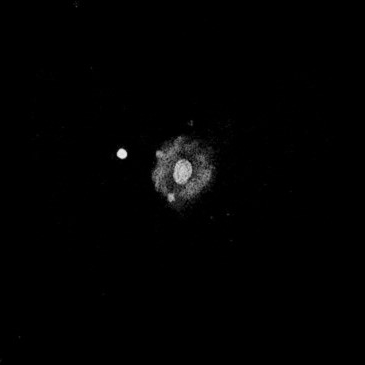
An inverted sketch of NGC 6058 by Dale Holt using a 14" Newtonian with a Watec video camera (North is down in the sketch.) Dale Holt - (19 May 2021).
-
NGC 2419 in Lynx
The generally cloudy weather of recent weeks gave few possibilities for imaging, so on the odd cloudless evening, I will tackle a subject that I can capture in a single evening. The enclosed image is of NGC 2419, The Intergalactic Wanderer, a globular cluster that has proved to be something of an enigma to understand.

This image of the globular cluster NGC 2419 in Lynx was provided by David Davies and taken from Cambridge in the UK. To see more of David's work please visit his Flickr Photostream. Click on the image for the larger version. NGC 2419 was discovered by William Herschel on December 31, 1788. It differs from most other globular clusters in that it is so distant from the centre of the galaxy that it was thought to be not in orbit about the galaxy and thus earned the nickname 'The Intergalactic Wanderer'. Studies of it now reveal that its orbit takes it out beyond the Magellanic Clouds and it takes three billion years to make one trip around the galaxy. It is at a distance of about 300,000 light-years from the solar system and at the same distance from the galactic centre. It presents a dim disc 4.5' across and has a magnitude of around 10. The brightest foreground stars in this image are around magnitude 8 but the brightest individual stars in the cluster itself are around magnitude 15.
Image Details
The data comprise 15 x five-minute sub-frames of RGB captured on the evening of 5th February 2021.
- Telescope: 200mm Ritchey-Chretien at 1660mm focal length.
- Camera: QSI 683 with Astrodon filters and a Lodestar as an off-axis guide camera.
- Mount: Skywatcher EQ8.
David Davies - (18 March 2021).
-
The Tadpole Nebula (IC410) in Auriga
Observing in the UK has been hampered by very poor weather for weeks. But, through January and February, I eventually managed to collect sufficient data on IC 410, The Tadpole Nebula. IC 410 is often depicted using narrowband data but I wanted to see what I could achieve in 'natural' RGB light.
Around 12,000 light-years away, in the constellation of Auriga, drifting clouds of gases are condensing into clusters of new stars. The hot young stars in these clusters ionise the gases, making them glow, and sculpt fascinating shapes by their energetic radiation.
One such star cluster, designated NGC 1893, formed around 4 million years ago and sits at the heart of such an emission nebula, IC 410, which is around 100 light-years across. In the image below, at the upper-left of the centre, two strange tadpole-shaped structures show where the radiation from new stars is causing the surrounding gas to glow, forming bright ridges of gas, the heads, while cooler gas streams away forming familiar tail-like shapes and giving rise to the nebula's nickname.
The star cluster, NGC 1893, was discovered in 1827 by John Herschel, but the surrounding nebula IC 410 was not detected until 1892, by the German astronomer and astrophotographer Max Wolf. Foreground dust and gas reduce the clarity of the nebula, something which I became aware of during the processing of the image.

This image of the Tadpole Nebula (IC410) in Auriga was provided by David Davies and taken from Cambridge in the UK. To see more of David's work please visit his Flickr Photostream. Click on the image for the larger version. Image Details
- Telescope: 200mm Ritchey-Chretien with a 0.7x reducer.
- Camera: QSI 683 plus a Lodestar off-axis guide camera.
- Mount: Skywatcher EQ8.
The image is an HaLRGB composition. It comprises 30 x five-minutes of luminance and 15 x five-minutes of each RGB. I also collected 10 x 20-minutes of hydrogen-alpha data and applied a small fraction of it as an additional luminance layer to help bring out the subtle structures in the nebula. Image acquisition with NINA; image processing with Deep Sky Stacker, Pixinsight and Photoshop.
David Davies - (25 February 2021).
-
Observations from Orion… at last
Last night I had my planetary head on mainly because Mike Wood had shown me his stacked video image of Abell 12 which was rather impressive and evidentially had impressed Owen Brazell too! After Mike showed me his image I went through my files expecting to find a drawing from some time or other but nothing!
I need to put that right so I went straight after Mu Orionis as I knew that Abell 12 lurked in the glare of this magnitude 4.1 star. I had the exposure of my Watec video camera turned down to 5 seconds and bang the ghostly round orb of Abell 12 aka PK 198-6.1 was obvious and striking next to the dazzling star with its large diffraction spikes.

An inverted sketch of Abell 12 by Dale Holt from his Chippingdale observatory in Hertfordshire. So to were Mu orionis Ab & Ba as this star is a 4 star multiple. I'm not sure if I could see the fourth member Bb as I had no idea where to look and as the faintest member it was most susceptible to Mu A's glare. Anyhow if I kept exposure relatively short then the other two were framed nicely between Mu A and Abell 12 adding to the spectacle considerably in my humble opinion.
Lengthening the exposure right up to 20 sec did nothing to enhance the detail seen in Abell 12 but it simply lost the multiple members in the glare and bloat of the primary. No central star was seen, mottling across the whole of the round and sharp edged planetary remained unaltered. The attraction of this PN is its ethereal appearance and contrast with its bright neighbour. A delight no less.
Next I went onto nearby Abell 14 another planetary with the PK designation of PK 197-3.1 This was to be a failure! This isn't the first time that I have tried and failed on this PN. It is very small 40"x27" and faint at magnitude 14. Tonight I had the location absolutely spot on but my camera could not pull it out even with a 25 sec exposure. It is obviously strong in the blue spectrum emission where my camera is less sensitive.
I dug out an old visual Lumicon 1.25 UHC filter and screwed this to the camera nose piece. I had to refocus and then I tuned the exposure up to 15sec then 20 sec with my fingers literally crossed but I could see not hide nor hair of this nebula! FAIL big style!
I then thought well I will leave the filter on and try the old favourite, NGC 2022, another planetary nebula in Orion and one I have been observing both visually and with video for 20 years or more. When the scope drive stopped NGC 2022 was bang in the centre of the field and strikingly obvious at 5 sec exposure. At 20 seconds it was incredibly detailed.

A inverted sketch of NGC 2022 by Dale Holt from his Chippingdale observatory in Hertfordshire. I dug out my file and looked at 3 previous sketches, better view tonight for sure 😀 I agonised over the sketch trying to show all the detail available. My new digital monitor is such that I can use a magnifying glass to study small objects and see yet more detail! I love it 😁
So that was 2hrs gone and time to get indoors and ready for bed, not that I slept! No,no way too excited.
Dale Holt - (11 February 2021).
-
NGC 1499 in Perseus
With this single colour shot of 500 second exposure Richard has captured a large portion of the California nebula (NGC 1499). Unfortunately it clouded over before he could get any additional frames.

The California nebula (NGC 1499) by Richard Weatherley taken from Northampton. Image Details
- Telescope: AG14 Orion F 3.8
- Camera: FLI Microline Camera
Richard Weatherley - (2 February 2021).
-
A few finds in Lepus
It was my initial intention to stay in Orion and look for more faint planetary nebulae. Here I have to report 2 failures.
The first one was absolutely zero seen of PK204-8.1, this according to images is a lovely ring structure. I could detect nothing, not a hint. I spent an hour trying with settings on the monitor and camera turning the exposure up to 20-sec integration and still nothing. I could see the stars that are superimposed on the nebula, all the field stars down to magnitude 19 or fainter but no nebulosity and I knew exactly where it would be!
Next PK215-30.1, I could see nothing at the location, looking at images this was less surprising than the first failure as it was a diffuse and tenuous nebula. Studying the monitor with the knowledge of what the nebula looked like, well maybe there was some milky structure there but I was far from sure so I moved on.
I dropped down into Lepus and changed quarry to galaxies.
Arp 123 was a revisit, last sketched back in 2013. This time I pulled out a little more of the dust lane than previously and sketched in some fainter stars than back in 2013. I also caught a nice little PGC 172117 with a central bulge just out of the field-of-view to the south. I made a quick shape sketch in the info margin of the main sketch.

Sketch of Arp 123 by Dale Holt from his Chippingdale observatory in Hertfordshire using his 505mm Newtonian with a Watec 120N+ video camera. Next I got a nice little first, NGC 1843 a fine SC spiral, magnitude 12.7, two arms seen, mottled central region and a couple of superimposed brighter stars, a nice object.

Sketch of NGC 1843 by Dale Holt from his Chippingdale observatory in Hertfordshire using his 505mm Newtonian with a Watec 120N+ video camera. IC 418 (PK 215-24.1) was an interesting and surprising observation, to cut a long story short, using the camera in the usual setting format the nebula appeared as a bright circular and uniform disc.
I know it is basically a fairly bright star and a faint spherical nebula in line of sight association. The camera appeared to be combining the two! If I turned it up to max 20-sec integration then the object displayed diffraction spikes. However if I turned the camera right down to a very short integration time that would just show down to magnitude 5-7 stars then a small nebulous disc appeared with an obvious associated star, as drawn. I can't work it out but I have recorded what I saw, and from my perspective it is what it was on the video camera.
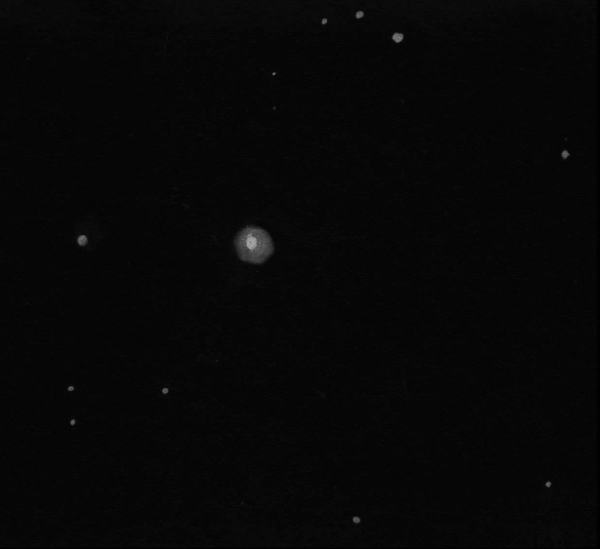
Sketch of IC 418 (PK 215-24.1) by Dale Holt from his Chippingdale observatory in Hertfordshire using his 505mm Newtonian with a Watec 120N+ video camera. That is all I have to share. This persistent haze or clag as they say north of Watford really has put the kibosh on what could have been a nice little winter run for us deep sky peeps.
Dale Holt - (21 January 2020).
-
Planetaries in Orion
Andrew Robertson challenged me with Abell 10 (PK 197-14.1) a couple of weeks back so that was my first object for last night.
Easily seen, increasing exposure time didn't make it much clearer but it did pull out more field stars. Disc distinctly mottled and 'fluffy' edged. Two stars to note on right-hand side of the disc, the upper slightly detached from the disc, the lower one was brighter and was superimposed on the disc.
There was I believe a very faint galaxy just in the upper left of the field-of-view, I didn't identify it or draw it in as it was so tenuous.
Abell 10, lovely object thanks to Andrew for bringing it to my attention 😊

Sketch of Abell 10 by Dale Holt from his Chippingdale observatory in Hertfordshire using his 505mm Newtonian with a Watec 120N+ video camera. Close by was PK 193.9.1 so I thought I would take a look, one catalogue stated it as being in Orion another as in Taurus.
Another nice planetary nebula, smaller than Abell 10 and dominated by its bright central star, it looked to be a tight almost perfect round shell, wonder what colour this appears to the eye?
Just outside of the upper field-of-view was a nice edge on galaxy, distinct but I didn't identify.
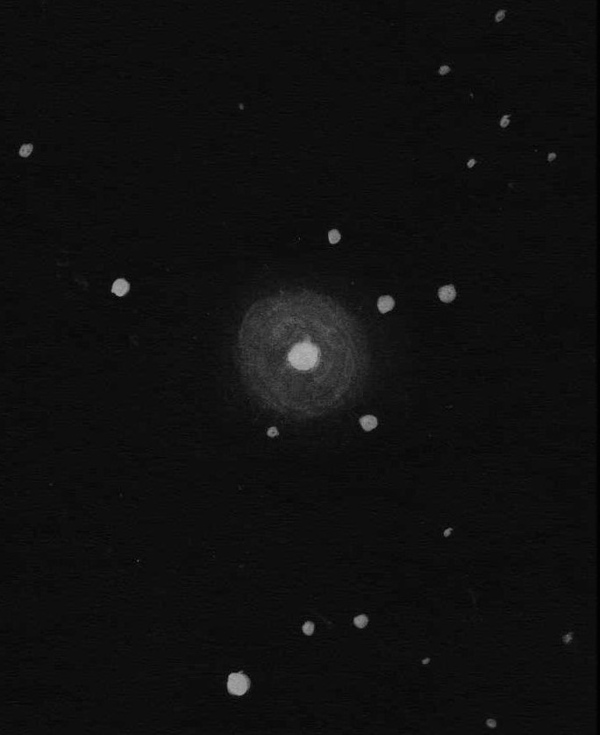
Sketch of PK 193-9.1 by Dale Holt from his Chippingdale observatory in Hertfordshire using his 505mm Newtonian with a Watec 120N+ video camera. Very enjoyable observing.
Dale Holt - (18 January 2020).
-
A Galaxy and a Flame
Last night's weather conditions could not have been better. I had a wonderful clear sky all night. This is something that we don't often see under British Skies.
This was good enough that I was able to finally save some ancient light from two targets. The first one is in the constellation Auriga, and the other one, in the late Winter-Spring constellation Leo.
NGC 2903 is a field barred spiral galaxy about 30 million light-years away in the constellation Leo. It was discovered by William Herschel who catalogued it on November 16, 1784. NGC 2905 is a bright star cloud within this galaxy. NGC 2903 has a very high speed of creating new stars in the central region. Wikipedia
- Distance to Earth: 30.66 million light years
- Magnitude: 9.7
- Apparent magnitude (V): 9.7
- Apparent size (V): 12'.6 × 6'.0
- Redshift: 556 ± 1 km/s
- Constellation: Leo

Barred Spiral NGC 2903 in Leo taken by Paul A Brierley using an Altair 115 EDT with an Atik 428EX and Atik EFWII. My picture was taken with 5-minute exposures x36 to give a total exposure time 3hrs.
IC 405 is an emission and reflection nebula in the constellation Auriga, surrounding the bluish star AE Aurigae. It shines at magnitude +6.0. Its celestial coordinates are RA 05h 16.2m dec +34° 28'. Wikipedia
- Magnitude: 6
- Apparent magnitude (V): 6
- Distance: 1500 ly
- Coordinates: RA 5h 16m 5s | Dec +34° 27' 49"
- Constellation: Auriga

The Flame Nebula (IC 405) in Auriga taken by Paul A Brierley using an Altair 115 EDT with an Atik 428EX and Atik EFWII. This picture was again 5 minutes in length. I took 24 exposures for this two-hour composite, using a 7nm Ha filter.
Paul A Brierley - (3 February 2019).
-
The Bubble Nebula (NGC7635) in Cassiopeia
David's Notes.
The Bubble Nebula in Cassiopeia, AKA Caldwell 11, is a favourite object for visual observers and imagers. The 'bubble' is about 10 light years across and some 11,000 light years away. The bubble has been created by a fierce stellar wind from a hot, young and massive central star. The star, SAO 20575, is thought to have a mass of 10 - 20 solar masses.
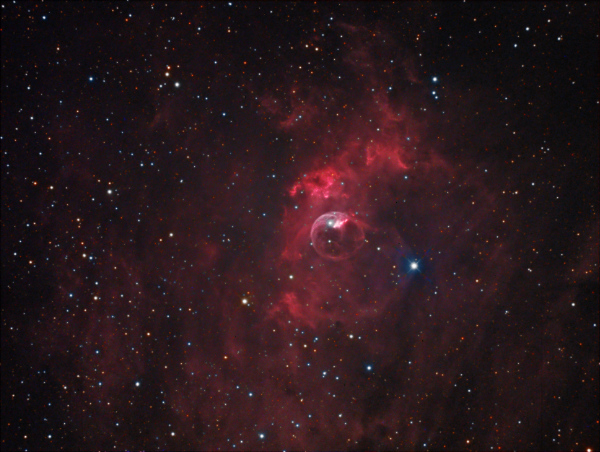
An LRGB image of the Bubble Nebula (NGC 7635) by David Davies from his Cambridge observatory in the UK. Image Details
I have been gathering data on the Bubble Nebula as a narrow band project for the past two months and have acquired some five hours of H-alpha, six hours of OIII and nine hours of SII. The SII signal is particularly faint. I then gathered a further 30 minutes each of RGB data to colour the stars.
I'm still processing this data and keep returning to it to see what further can be done, but since the results thus far are quite attractive, I thought I'd share them with you on this Christmas Eve (which he did, I'm just a bit slow sharing it with all of you - James).
I've constructed a 'super luminance' image from the sum of the narrow band images and applied it to the RGB image to produce the LRGB image, above. The narrow band image is presented in the Hubble palette, but I have yet to substitute the RGB star data to correctly colour the stars.
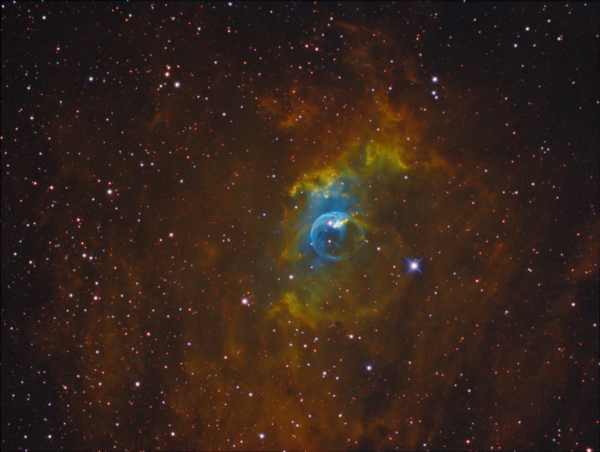
The Bubble Nebula (NGC 7635) in narrow band Hubble palette by David Davies from his Cambridge observatory in the UK. Equipment
- Telescope
- 8-inch Ritchey Chretien at f/8.
- Camera
- QSI 583 plus Astrodon RGB filters and Lodestar guider.
- Mount
- Modified Skywatcher NEQ6
- Software
- Deep Sky Stacker, Pixinsight and Photoshop
David Davies - (24 December 2016).
For more images from David please visit his Flickr Photostream.
-
Abell 84 in Cassiopeia
 Image courtesy of Mike O'Brien.
Image courtesy of Mike O'Brien.
Image Details
70 minutes in Hydrogen Alpha composed of 7 x 10 minute lights.
Equipment
- Telescope
- 12" Skywatcher PDS
- Camera
- Atik 314L+ mono
- Mount
- Skywatcher AZEQ6GT
- Guiding
- Starlight express mini USB filter wheel with built–in off axis guide prism and Orion G3 camera
Mike O'Brien - (24 October 2016).
-
The Ring Nebula (M57) in Lyra
For the first time in ages I got out the telescope for a very short session on Sunday night, 17 July 2016. The moon was about 95% full and it was my main target for the two hours I was out. The air was very warm at about 14°C and this was the first time I that I have observed wearing a short sleeve t shirt! It was so warm all my family came out to enjoy spectacular images of the Moon.
However, I did observe M57 and the lovely classic double Alberio in Cygnus. I normally use large dobsonians for my observing but this time I used my (apo) refractor, a CFF 127mm f7 on a NEQ6 mount. This made quite a change for me! I was out in the garden from about 22:00 until 24:00 UT. With a nearly full Moon it was not a night for deep sky objects but I just wanted to be outside with a telescope again.
I made my sketch of M57 using an Ethos 6mm eyepiece giving x148. The low contrast was exacerbated by the closeness of Cygnus to the Moon. The lovely M57 appeared as a dim smoky ring with a dimmer centre. The view was very different to that I normally see with the dobs!

I then turned to Alberio which I often look at. Although it is probably a hackneyed target for double star observers (of which I am not one) I never tire from looking at the lemon and pale blue pair. A real delight.
David Reynolds in South Norfolk (18 July 2015).
-
The Triffid Nebula (M20) in Sagittarius
 Image Courtesy of David Davies, Cambridge, UK.
For more images from David please visit his
Flickr Photostream
.
Image Courtesy of David Davies, Cambridge, UK.
For more images from David please visit his
Flickr Photostream
.
David's Observation Notes.
June and July are very difficult times for astronomers with no astronomical darkness and just two hours of barely usable skies between 12 midnight and 2 am; by 2:30 am the coming dawn is lighting the north eastern sky.
The attached image of M20 was captured over two nights on 1 and 3 July. M20 is a tricky target in the UK as it doesn't rise above 15 degrees altitude and so is not visible for long. Also, the low altitude means that M20 is in the murky atmosphere close to the horizon. I was keen to try M20 as I managed to image it two years ago with my ED120 refractor and wanted to see what the how the Ritchey Chretien telescope would perform.
The Triffid Nebula is a star forming region in Sagittarius similar to the Orion nebula. At its centre is a multiple star system designed HN 40 which, I have read, contains six components, one of which is a hot blue giant star (spectral type O7) that is flooding the region with UV radiation, ionising the interstellar hydrogen gas, and producing the pink nebula. Further out, cooler stars are illuminating dust and gas producing the blue reflection nebula.
In this image I have managed, with a little image processing, to just about resolve five of the six components of HN 40.
To capture this image I sacrificed resolution for increased camera sensitivity and captured the image at 2 x 2 binning, giving an image scale of 1.36 arc seconds per pixel. The two-minute exposures just saturated the brightest stars on the luminance frames.
Image Details
40 minutes luminance & 20 minutes each of RGB data in 2-minute subs; The image is a crop at 37 x 28 arc minutes at 1.36 arc seconds per pixel
Equipment
- Telescope
- 8-inch Ritchey Chretien at f/8.
- Camera
- QSI 583 plus Astrodon RGB filters and Lodestar guider.
- Mount
- Modified Skywatcher NEQ6
- Software
- Scopefocus; PHD2: EQMOD; Carte du Ciel; Deep Sky Stacker, PixInsight; Photoshop CC2015
David Davies - (5 July 2016).
-
Observing at Teggs Nose with Binoculars
I was lucky enough to see a clear sky during Friday evening. After the rain had cleared off. The skies were clear although. There was a lot of moisture around. This moisture eventually froze out. Leaving a sharp hoar frost at dawn.
Tegg's Nose country park was my destination. I travelled up there from my home in Macclesfield. Although this site is not far from the centre of the town. The skies can be quite dark. Normally we can see magnitude 4.6 stars, and on those rare occasions, magnitude 5.
The Moon was visible during the early evening. But she wasn't a problem. It was a thin crescent hanging majestically in the western sky.
I was with members from my local astronomical society's observing group. And we had a good time.
I was up there to take pictures of Orion and the famous nebulae. But I also wanted to use my 20 x 70 observation binoculars.
M42 was a magnificent sight through my tripod mounted binoculars. I counted all four stars of the trapezium, and I was able see Sigma Orionis and see the companion stars.
Lepus the Hare was very clear last night. The Alpha and Beta stars were crystal clear. I thought I might see M79. But I failed. I will try again on the next clear, Moonless night we have.
Messier 41 was very clear, together with Sirius.
NGC 2237, the open cluster at the centre of the Rosette nebula. Was another easy target. And comet Catalina was a large fuzzy blob just North of Alkaid.
M42 and the nebula NGC 1973-75-77 are shown in this picture. I used a Canon 1000D with a 200mm Pentacon telephoto lens. This was attached to my Skywatcher Star Adventurer.

Paul Brierley - (16 January 2016).
-
A Haul of Deep-Sky Sketches
This is the best haul of deep sky sketches that I have had for quite some while!
The two planetary nebulae NGC 2022 and NGC 22371/2372 are 're-visits' I have sketched both of these before but years ago with my old 350mm Newtonian and Watec camera, the level of detail is significantly higher in these new sketches.

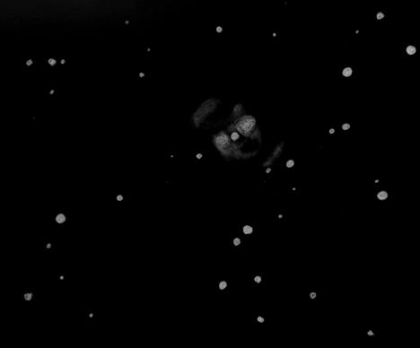
ARP 186 was a challenge, especially seeing the slender trunk like projection/arm there are also another 3 small faint galaxies in the field, these I have not identified.

Some nice detail can be seen in NGC 1924 a rare Orion galaxy and a first observation for me, note also a faint unidentified galaxy to the upper right of my sketch and what appeared to be another spiral directly below the main galaxy, again unidentified.
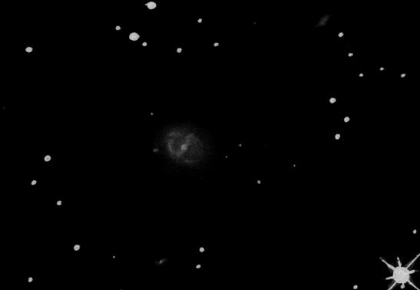
NGC 1964 in Lepus was disappointing until I went out into the observatory and saw just how low the scope was pointing into the murky glow in London's direction!

Finally a first visit for me to a lovely galaxy trio in Gemini, another constellation not normally associated with galaxy hauls.The largest spiral which I believe is NGC 2389? shows some great detail.

Dale Holt - (8 January 2016).
-
NGC 2371 / NGC 2372 in Gemini
I was delighted to see some more detail recently in this lovely and very interesting planetary nebula, which I will recount to you. At long last the poor weather relented and I managed to use my telescope for what turned out to be almost an 'all nighter'.
Tuesday 08 December 2015 was forecast to be clear well in advance and so many local astronomers got out to enjoy the night sky. I turned my 600mm f4.5 dobsonian onto a good range of objects including this Planetary Nebula (PN) in Gemini, sometimes called The Peanut because it is bi-polar, hence the reason why it was given two NGC names. Conditions were not particular good; the darkness was only SQM 20.79 which is very poor for this site, but transparency was average to good. Seeing was poor.
I spent thirty minutes studying this interesting planetary, starting at 01:35 UT early on Wednesday morning (night of 08/09). With a magnification of x 340 (Ethos 8mm) and then x570 (Ethos 4.7mm), the overall shape was of a pear drop. For once, the nick name peanut is accurate. Of the two brightest patches the Southern end was slightly brighter and smaller. The opposite end, Northern, was broader forming the wider base of the pear drop, with some much fainter nebulosity extending Westward. Fainter nebulosity filled the space between them with a slightly brighter band joining the two lobes on the Eastern edge. I then tried adding a UHC filter to the 8mm Ethos. Almost immediately I thought I could see some additional nebulosity outside the 'normal' planetary. After some minutes I was sure I could see very faint but definite curved bands on the West and East sides of the main body, with a clear gap between the 'pear' and the bands. They appeared to follow the curve of the planetary as if forming parts of a shell. The East section was larger - longer and wider at the South end with a much wider section going Eastwards. The West section also had a 'T' piece at the South end but much smaller. These shells were very faint and required AV2 to see (averted vision, but is held steady). I also noticed that the band joining the two parts of the bi polar planetary was very slightly brighter in the middle. The central star was prominent throughout.
I made a couple of sketches and the enclosed one illustrates, as best I can because I am not an artist of any sort, the view at x340 with the UHC filter. The outer shells are more prominent in the sketch than I saw them.
I have looked at this planetary many times over the years with various instruments but I have never seen the outer shells before now, and neither did I know of their existence. The following day I checked my usual (printed) sources and none mentioned this feature. However, an internet search revealed a DSS image of the the shells in exactly these positions.

Image Credit: Digital Sky Survey (DSS).
Pleased! It was a great night and I also enjoyed another great planetary and five Hickson Groups including Copeland Septet. Roll on the next clear skies.
David Reynolds (16 December 2015).
-
Observation of the NGC 1555 in Taurus
Had a look at a couple of objects in the only clear part when it cleared out in the vicinity of Hind's Variable. I’ve looked for this on numerous occasions with both my 24” Dob and 18” Dob without success but I remember David Reynolds saying he thought he’d glimpsed it with his 20” from Haw Wood last week so I thought I’d give it a go.
Got onto the correct field and I saw it straight away (SQM 21.36 NELM 5.5) AV1 – easy averted vision and bordering on direct vision when I looked at it. This was with a 13mm Ethos giving x208. But almost immediately thin cloud started obscuring the view followed by thicker cloud. I drew a positional sketch but couldn’t get any detail of the nebula. It appeared at this point to be touching the associated star.
I couldn’t get back on this until 0550 – 0555 BST after astronomical dark had ended (0534) but the view was better (no cloud) and I observed it with a 8mm Ethos (x340). This time I could see that the nebulosity was detached from the star and amended the sketch accordingly. I can only presume this has brightened – a first sighting for me.
Andrew Robertson - 20 October 2015
-
NGC 1501 in Camelopardalis
I was out last Tuesday for a few hours and for once the clouds had the decency to delay their appearance until the moon was up at around 23:00 UT. I was using my 600mm f4.5 dob and the thin high cloud meant that it was not a night for the faint stuff. My Sky Quality Meter L read about 20.80 and the air temperature at minus two, and I judged the seeing to be 'average'. One of the objects I observed was a very nice planetary nebula NGC 1501 in Camelopardalis, which shows some nice detail to medium sized telescopes and above.

With an 8mm Ethos eyepiece and O3 filter I recorded the following in my notes:- Circular, large, central hole slightly oval in the NE-SW direction, brighter arc on the E edge of the PN extending about one-sixth of the circumference. which appeared to 'shimmer' or glitter! The best view was with AV1 (averted vision level 1). No sign of central star, no colour noted.

Using the same eyepiece but without the O3 filter, the PN was more easily seen. The central star was bright and obvious, mottling within the nebulosity with brighter patches to the N and W of the CS. No colour seen. The PN is flanked by three field stars spread symmetrically around the planetary.
David Reynolds (10 March 2015).
-
Messier 76 in Perseus
 Image Courtesy of David Davies, Cambridge, UK.
For more images from David please visit his
Flickr Photostream.
Image Courtesy of David Davies, Cambridge, UK.
For more images from David please visit his
Flickr Photostream.
David's Observation Notes.
Hello everyone,
The poor weather in late November meant that I was able to get out only twice, the 23rd and 29th. The 23rd was a new moon but the forecast was very poor for the next week so I decided to try Messier 76 in hydrogen alpha - at least that way I could return to it on the next fine night and capture more narrow band data, even though it might be close to full moon. Sure enough the next fine night the 29th was close to full moon and I returned to M76 and see what oxygen III and sulphur II data I could capture.
In the end I managed to capture two hours each of H-alpha, Oxygen III and Sulphur II. The core of M76 is relatively bright and showed up well but the outer regions are very faint and needed some teasing out in processing.
I've tried both a Hubble palette (red, green, blue is derived from sulphur, hydrogen and oxygen, respectively) and the less frequently seen HOS palette (red, green, blue is derived from hydrogen, oxygen and sulphur, respectively). The Hubble palette gives a predominantly blue image from which it was difficult to tease out any detailed structure. The HOS palette yielded a green/yellow and red image and more of the detail could be teased out by tweaking the colour balance in Photoshop.
So this is Messier 76 in HOS palette. Six hours of data was captured in 20 minute subs, equally split between hydrogen-alpha, oxygen III and sulphur II.
Image details
- Image Processing
- Pixinsight and Photoshop.
- Telescope
- 254 mm Newtonian with Tele Vue Paracorr at F/4.5
- Camera
- QSI 583wsg with Astrodon 3 nm narrow band filters. Off-axis guiding by SX Lodestar.
- Mount
- EQ6 controlled by EQMOD
-
NGC 281: the Pacman Nebula
 Image Courtesy of Paul A Brierley, East Cheshire, UK.
Please click on the image for the high resolution version.
Image Courtesy of Paul A Brierley, East Cheshire, UK.
Please click on the image for the high resolution version.
I hope you are all enjoying this pre equinox sunshine.
When the skies where I live, in East Cheshire, finally cleared least night. I was able to take 15 minute exposures of the "Pacman nebula" that is currently visible high in the Autumn sky near the star Schedar, Alpha Cassiopeiae.
I used the usual equipment. And took 1¾ hours of image data, all 15 minutes through a Baader 7nm Ha filter.
The images were stacked in DSS and post-processed in Startools and CS2. CCD and mount control via SGPro and PHD 1.

